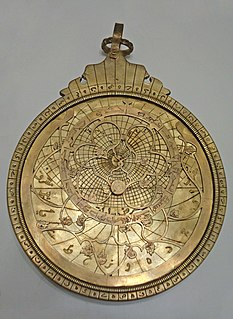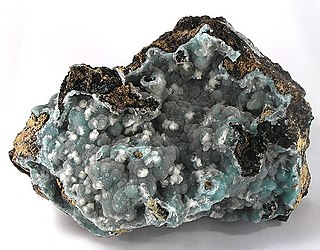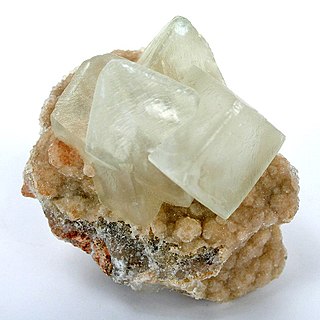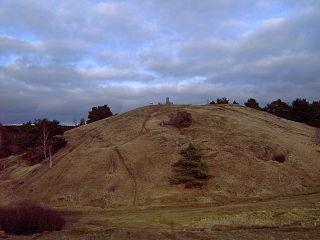
Brass is an alloy of copper and zinc, in proportions which can be varied to achieve varying mechanical and electrical properties. It is a substitutional alloy: atoms of the two constituents may replace each other within the same crystal structure.

Zinc is a chemical element with the symbol Zn and atomic number 30. Zinc is a slightly brittle metal at room temperature and has a blue-silvery appearance when oxidation is removed. It is the first element in group 12 of the periodic table. In some respects, zinc is chemically similar to magnesium: both elements exhibit only one normal oxidation state (+2), and the Zn2+ and Mg2+ ions are of similar size. Zinc is the 24th most abundant element in Earth's crust and has five stable isotopes. The most common zinc ore is sphalerite (zinc blende), a zinc sulfide mineral. The largest workable lodes are in Australia, Asia, and the United States. Zinc is refined by froth flotation of the ore, roasting, and final extraction using electricity (electrowinning).

Calamine is a historic name for an ore of zinc. The name calamine was derived from lapis calaminaris, a Latin corruption of Greek cadmia (καδμία), the old name for zinc ores in general. The name of the Belgian town of Kelmis, La Calamine in French, which was home to a zinc mine, comes from this. In the 18th and 19th centuries large ore mines could be found near the German village of Breinigerberg.

Kelmis is a municipality located in the Belgian province of Liège, named for the historical deposits of calamine nearby. As of 2011, the population was 10,881; the area is 18.1 square kilometres (7.0 sq mi) and the population density is 601.2 inhabitants per square kilometre (1,557/sq mi).
Lucerne is a city in Switzerland.

Hemimorphite, is Zn4(Si2O7)(OH)2·H2O, a component of calamine. It is a sorosilicate mineral which has been historically mined from the upper parts of zinc and lead ores, chiefly associated with smithsonite, ZnCO3. They were assumed to be the same mineral and both were classed under the same name of calamine. In the second half of the 18th century it was discovered that these two different minerals were both present in calamine. They closely resemble each other.

Smithsonite, or zinc spar, is zinc carbonate (ZnCO3), a mineral ore of zinc. Historically, smithsonite was identified with hemimorphite before it was realized that they were two different minerals. The two minerals are very similar in appearance and the term calamine has been used for both, leading to some confusion. The distinct mineral smithsonite was named in 1832 by François Sulpice Beudant in honor of English chemist and mineralogist James Smithson (c.1765–1829), whose bequest established the Smithsonian Institution and who first identified the mineral in 1802.

The cementation process is an obsolete technology for making steel by carburization of iron. Unlike modern steelmaking, it increased the amount of carbon in the iron. It was apparently developed before the 17th century. Derwentcote Steel Furnace, built in 1720, is the earliest surviving example of a cementation furnace. Another example in the UK is the cementation furnace in Doncaster Street, Sheffield.
Antipruritics, also known as anti-itch drugs, are medications that inhibit the itching often associated with sunburns, allergic reactions, eczema, psoriasis, chickenpox, fungal infections, insect bites and stings like those from mosquitoes, fleas, and mites, and contact dermatitis and urticaria caused by plants such as poison ivy or stinging nettle.
The term latten referred loosely to the copper alloys such as brass or bronze that appeared in the Middle Ages and through to the late 18th and early 19th centuries. It was used for monumental brasses, in decorative effects on borders, rivets or other details of metalwork, in livery and pilgrim badges or funerary effigies. Latten commonly contained varying amounts of copper, tin, zinc and lead, giving it characteristics of both brass and bronze. Metalworkers commonly formed latten in thin sheets and used it to make church utensils. Brass of this period is made through the calamine brass process, from copper and zinc ore. Later brass was made with zinc metal from Champion's smelting process and is not generally referred to as latten. This calamine brass was generally manufactured as hammered sheet or "battery brass" and cast brass was rare.

Calamine, also known as calamine lotion, is a medication used to treat mild itchiness. This includes from sunburn, insect bites, poison ivy, poison oak, or other mild skin conditions. It may also help dry out skin irritation. It is applied on the skin as a cream or lotion.
Calamine brass is brass produced by a particular alloying technique using the zinc ore calamine directly, rather than first refining it to metallic zinc. Direct zinc smelting appears to have been unknown in Europe until the mid-18th century, even though the alloyed calamine brass was in use for centuries, and metallic zinc was produced directly via reducing-atmosphere smelting in India and China from the 12th century CE onwards.
In medicine, an Unna boot is a special gauze bandage, which can be used for the treatment of venous stasis ulcers and other venous insufficiencies of the leg. It can also be used as a supportive bandage for sprains and strains of the foot, ankle and lower leg. The gauze is impregnated with a thick, creamy mixture of zinc oxide and calamine to promote healing. It may also contain acacia, glycerin, castor oil and white petrolatum.

The nature reserve of Schlangenberg which means snake-mountain is located in the west of Germany close to the Dutch and Belgian border. The reserve is near the village Breinigerberg, 15 kilometres from Aachen or 7 kilometres distant from the city of Stolberg (Rhineland). Schlangenberg itself is a small hill peaking 276 m above sea level.

Calamine is an unincorporated community in the town of Willow Springs in Lafayette County, Wisconsin, United States. The Cheese Country Trail runs through the community, as does the Pecatonica River. The community is home to St. Michael Church, within the Roman Catholic Diocese of Madison.

Calamine is an unincorporated community in Sharp County, Arkansas, United States.

Saltford Brass Mill is a brass mill on the River Avon at Saltford, Somerset, England. It dates from the 1720s is listed as Grade II* and is also a Scheduled Ancient Monument.
Pine Bluff commonly refers to:











